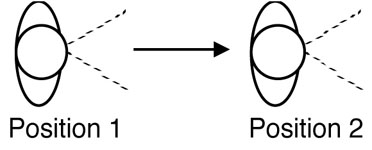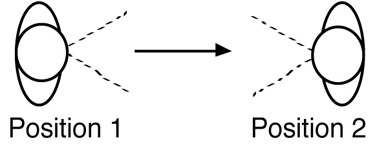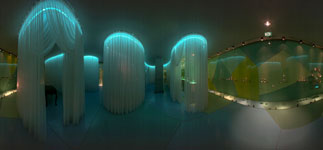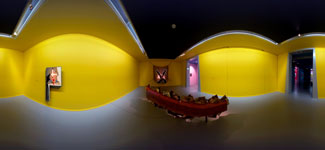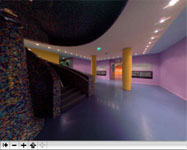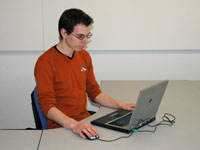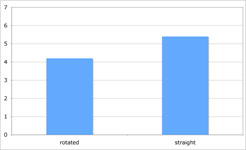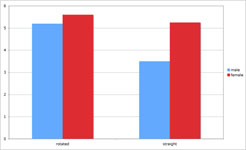CITEULIKE: 1575188 | REFERENCE: BibTex, Endnote, RefMan | PDF ![]()
Bartneck, C. (2007). Navigation styles in QuickTime VR scenes. Proceedings of the HCI International Posters: Part VII - Virtual and Augmented Environments, Beijing pp. 801-805.
Navigation Styles in QuickTime VR Scenes
Department of Industrial Design
Eindhoven University of Technology
Den Dolech 2, 5600MB Eindhoven, NL
christoph@bartneck.de
Abstract - This paper presents an empirical study on two different navigation styles within QuickTime VR panorama scenes. In one style, the users would jump from one position in the scene to the next while maintaining their direction of view. In the second style, the users would jump from one position to the next and reverse their direction of view. The results show that participants preferred the later style because it enabled them to more quickly return to their original positions.
Keywords: Panorama, QuickTime VR, Navigation, 360, Photography
Introduction
This paper investigates two navigation styles for panoramic scenes. QuickTime Virtual Reality (QTVR) is a technology developed by Apple [1], which enables users to experience and interact with spatial scenery on their computer. Virtual Panorama technology has been widely used by hotels, parks and recreation centers to enable their prospective guests to view their facilities up front through the internet. Also car producers, such as Ford or Toyota, use this technology to showcase their vehicles.
Fig. 1. Straight interaction style
Multiple panoramas can be linked together by hotspots to create a scene. The user can than jump from one panorama to the other by clicking on the hotspots. Jumping from one panorama to the other often causes confusion for the user. They have difficulties to understand the spatial relationship between the panoramas and to build a mental map of the environment. There are two interaction styles for the jump that are defined by the designer of the scene. The user may jump and look in the same direction in which he moved (see Figure 1) or he may look back from where he came from (see Figure 2),
Fig. 2. Rotated interaction style
Both interaction styles have advantages. The straight interaction style resembles movement in the real world. When we walk from one position to another we keep the direction of our field of view. However, if the panoramas were shot in great distance from each other, then the user does not see anything familiar when he enters the new panorama. It is also difficult for him to find the hotspot that takes him back, because from a great distance his original position may look very small. The rotated interaction style does not resemble movement in the real world. We do not change our field of view when we walk from one position to another. However, the user always faces his starting position and therefore he or she can easily click back to it. The user needs to adapt to this interaction style, but once learned it might be easier to use, particular in confusing environments or when the panoramas were shot in great distance from each other. The research for this study is therefore what influence has the interaction style on the perceived ease of navigation in a QTVR scene.
Method
Design
A between participant experiment was conducted in which the interaction style was the independent factor. The perceived ease of navigation was the dependent variable. It was measured by a questionnaire.
Material
This study used the panoramic virtual tour of the Groniger Museum, The Netherlands which is available on the internet [5]. The building of the Museum has been designed by three architects: Mendini, Starck and Himmelbau (see Figure 3). The environment itself has influence on the difficulty of navigation. The Groninger Museum tour incorporated several typical environments [2]. The outside panoramas are shot in great distance from each other, the Mendini section consisted of regular rectangular and colorful rooms (see Figure 4), the Starck section contained confusing curtains and the deconstructive architecture of the Himmelbau section is extremely irregular (see Figure 5).
Fig. 3. The Groninger Museum from the outside.
Fig. 4. Panorama of an irregular room.
Fig. 5. Panorama of a regular room.
Apparatus
The introduction text, the QTVR scene and the questionnaire were presented on a laptop. The QTVR scene was presented in a 320x240 pixel window (see Figure 6) on a 12 inch LCD laptop screen.
Fig. 6. QTVR interface used in the experiment
The laptop was placed on a desk and the participants were seated directly in front of it (see Figure 7).
Fig. 7. Setup of the experiment
Procedure
After entering the room the participants were given a short introduction to the experiment and were given the opportunity to ask questions. The user of virtual panoramic tours do usually not have a specific goal, such as finding a specific piece of art, but simply want to experience the environment.
QTVR is not yet a commonly used technology on the Internet comparison to Flash or the upcoming AJAX. Most of the Internet users have probably never used QTVR before and to ensure a realistic setup we did not provide any training in QTVR navigation before the exploration task. The participants were therefore asked to directly explore the museum for twelve minutes. The fixed duration ensured that all participants hat the same experience. Afterwards the participants had to fill in an ease-of-use questionnaire which featured several items that had to be answered on a seven point rating scale ranging from 1=completely agree to 7=completely disagree. Afterwards a text box in which they could freely enter comments was offered on the computer screen. Lastly, the participants were debriefed. The whole experiment took approximately 20 minutes.
Subjects
20 members of the Technical University of Eindhoven, aged from 23 to 45, participated in the experiment (9 female and 11 male).
Results
Figure 8 shows the perceived ease of use depending on the interaction style. The straight interaction style was rated significantly higher (t[19]=-2.151, p=.045) and therefore more difficult than the rotated interaction style.
Fig. 8. Perceived ease of use per interaction style. 0 equals easy and 7 equals difficult.
Figure 9 shows the perceived ease of use divided by gender. There is no significant difference. However, there is quite a large trend in the rotated style condition. The male perceived this style as much easier than the female.
Fig. 9. Perceived ease of use per interaction style and gender (0 equals easy and 7 equals difficult.)
Conclusion
The rotated interaction style is perceived easier to navigate with than the straight interaction style. Once this interaction style is learned it gives the subjects an easy way to return to their last position. This security has positive influence on the perceived ease of navigation. Most subjects commented that they would like to have a map of the museum as an additional navigation aid. Norris, Rashid and Wong [3] investigated the potential benefit of providing such a map. Their results show that a map does not support exploration tasks. The environment in which the panoramas where shot could have influence on the perceived ease of navigation. The straight style might be easier for regular rooms and the rotated interaction style might be better suited for confusing environments. Further research that investigates this factor is necessary.
Bibliography
- Apple Computer. (2001). QuickTime VR. Retrieved January 2001, from http://www.apple.com/quicktime/technologies/qtvr/
- Groninger Museum. (2001). Website of the Groninger Museum. Retrieved January 2001, from http://www.groninger-museum.nl
- Norris, B., Rashid, D. Z., & Wong, W. (1999). Wayfinding/Navigation within a QTVR Virtual Environment: Preliminary Results. Proceedings of the 13th Interact Conference.
- Spheron VR. (2001). Spehron VR Website. Retrieved January 2001, from http://www.spheron.com
- Bartneck, C. (2001). Virtual tour of the Groninger Museum. Retrieved January 2007, from http://www.bartneck.de/work/qtvr/gmvr/
This is a pre-print version | last updated February 5, 2008 | All Publications
